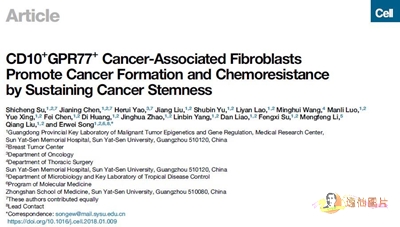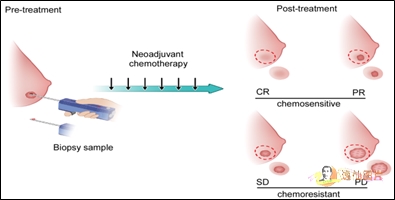A new chemoresistance mechanism regulated by fibroblasts subpopulation was revealed by Dr. Erwei Song's team
Dr. Erwei Song and Dr. Shicheng Su’s team from Sun Yat-sen Memorial Hospital, Sun Yat-sen University identified a chemoresistance-associated fibroblasts subset with specific cell surface markers CD10 and GPR77 for the first time. Related research was published online January 25, 2018 in Cell.

As we all know, tumor cells just like "seeds", their growth are relied on the fertile soil, that is, the tumor microenvironment. Carcinoma-associated fibroblasts (CAFs) are the most abundant stromal cells in tumor microenvironment, which are critically involved in chemoresistance. However, recent clinical studies suggest that fibroblast-targeted therapy instead accelerate the progression of cancer. At the same time, the previous researches reveal that CAFs are heterogeneous and the lack of effective surface markers really hinders their application in diagnosis and targeted therapy.
In order to effectively circumvent the influence of clinical treatment on tumor biological characteristics, Dr. Erwei Song’ team first employed the clinical model of neo-adjuvant chemotherapy for breast cancer to carry out the research. Their research found that the number of CAFs in tumor samples obtained prior to treatment was not related to the future chemosensitivity of the tumor. In contrast, following neo-adjuvant chemotherapy, CAFs were scarcely found in the residual tissues of the responsive patients compared to the resistant ones. In in vitro experiments, fibroblasts isolated from chemoresistant samples and chemosensitive samples respectively were co-cultured with tumor cells. When challenged with chemotherapeutic drugs, more tumor cells survived upon co-culturing with CAFs isolated from the chemoresistant samples, rather than CAFs from the chemosensitive ones. This result further confirmed that there are different subsets of fibroblasts in tumor that play different biological functions.
In addition, by comparing the gene expression profiles of fibroblasts isolated from chemoresistant and chemosensity samples respectively, their research identified a novel CD10+GPR77+ fibroblasts subset and revealed that the density of this subset of fibroblast was associated with poor prognosis and chemoreisistance of breast cancer and lung cancer patients. By comparing the difference of gene expression profiles of drug-resistant and susceptible fibroblasts, a CD10 + GPR77 + fibroblast subpopulation was identified by using two cell membrane proteins, CD10 and GPR77, and found that the number of fibroblasts of this type correlated with breast Prognosis of patients with cancer and lung cancer is associated with chemosensitivity. This suggests that detecting the number of specific subset of fibroblasts in tumor samples before treatment is expected to be an effective clinical predictive and prognostic indicator for breast and lung cancer.

In order to simulate the patient's tumor microenvironment maximally, researchers employed an patient-derived xenografts(PDX)model. They directly transplanted the fresh human tumor samples which were rich of CD10+GPR77+ fibroblasts in mice fat pads and the sunsequent combined treatment of docetaxel with anti-GPR77 antibody significantly reduced the tumor growth of the implanted PDXs. Collectively, the research revealed that blocking GPR77 with antibody promised an effective therapeutic strategy in enhancing chemotherapeutic effects and suggested a significant research value of tumor microenvironment targeted therapy.
Writter:Breast Tumor Center, Sun Yat-sen Memorial Hospital, Sun Yat-sen University
Editor: the Office of International Affairs and the CPC Committee Office, Sun Yat-sen Memorial Hospital, Sun Yat-sen University


